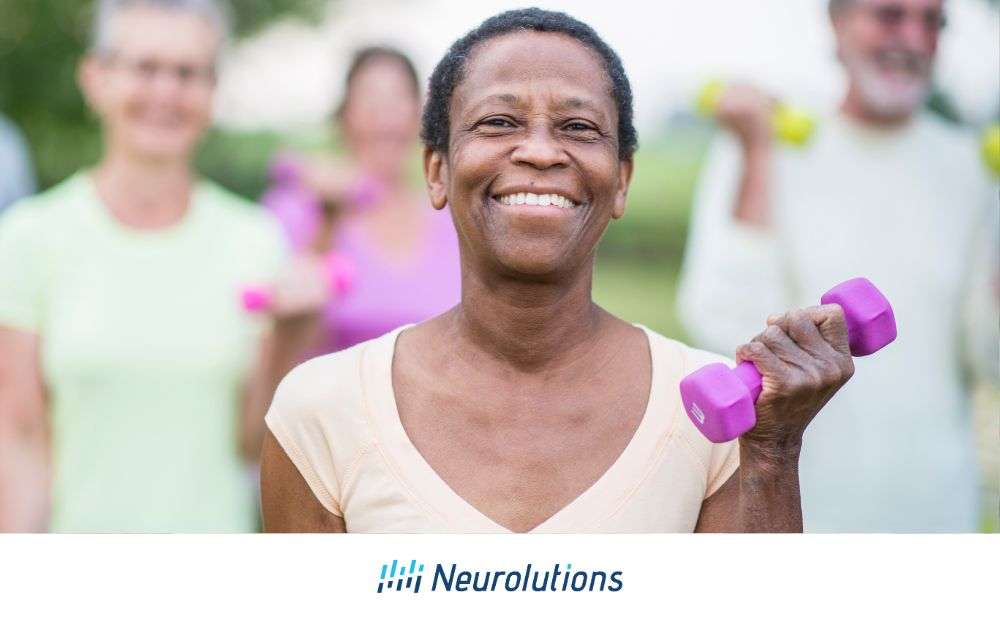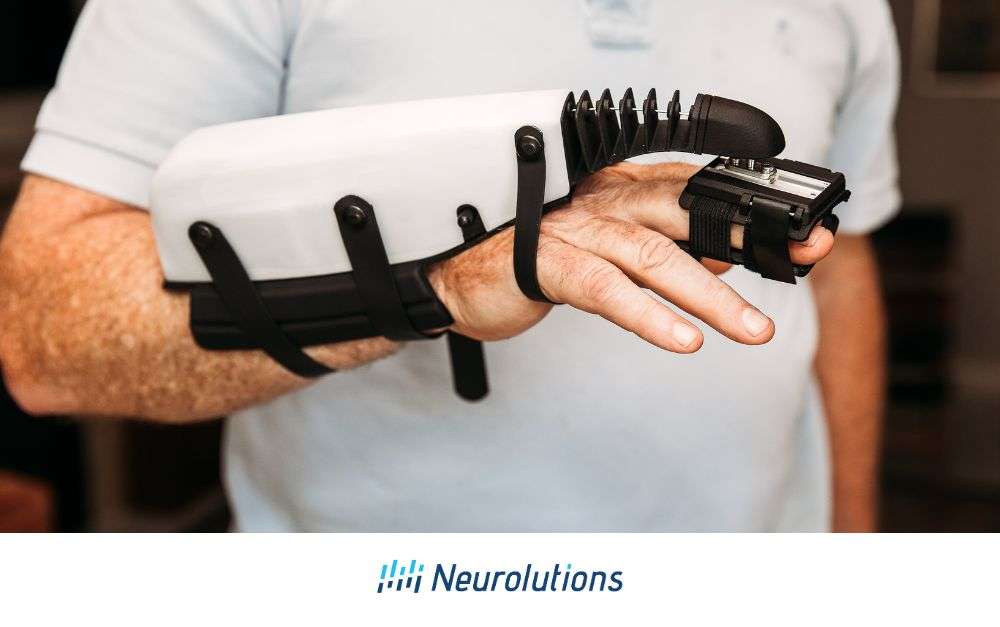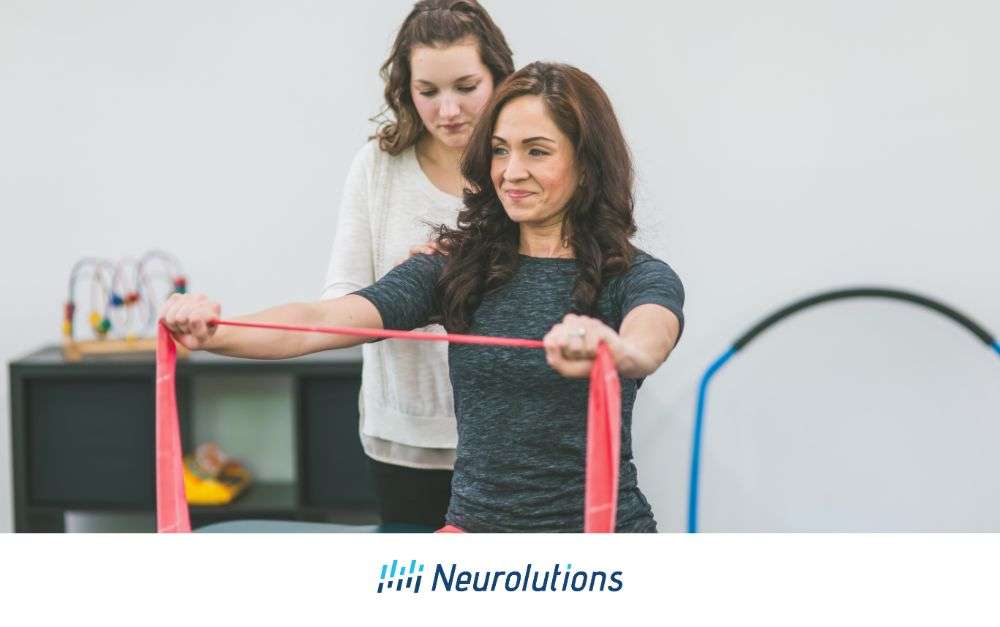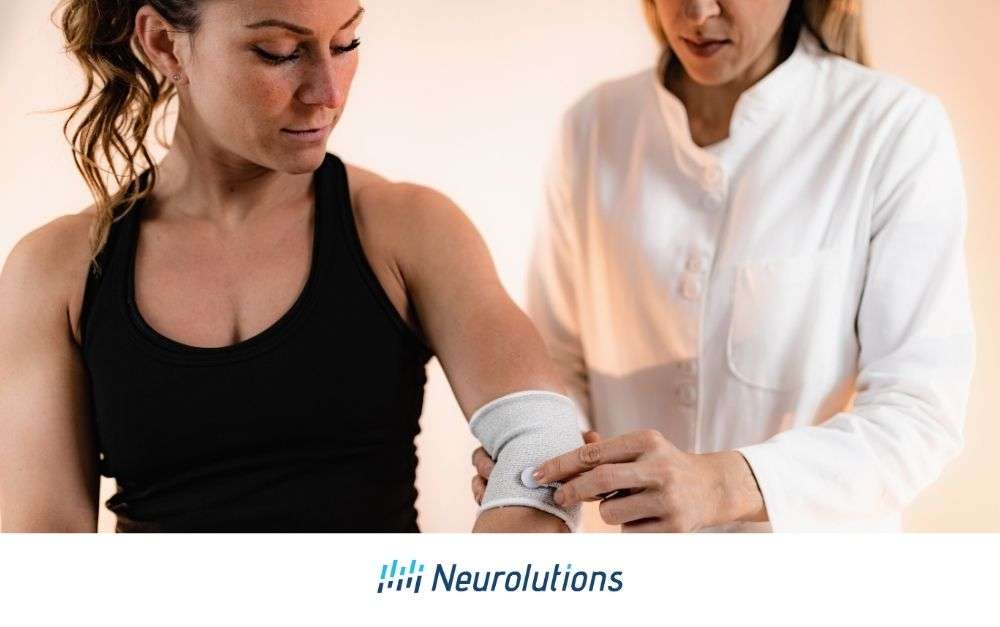After a stroke, many patients experience paralysis or weakness on one side of the body, including in the wrist, forearm, hand, and fingers. This can impact a survivor’s ability to perform everyday tasks and affect their overall quality of life. Around 77% of all stroke survivors have ongoing weakness in their upper extremity, while 72% experience lower extremity weakness (1).
Following a stroke, healthcare providers generally recommend physical and/or occupational therapy (PT and/or OT). While PT focuses on overall movement recovery, OT specifically targets improving wrist, hand, and finger function and its relation to daily function. Both types of therapy can help a stroke survivor regain independence in performing daily activities.
This article aims to describe the stages of hand function recovery after a stroke, the importance of PT and OT, and practical strategies that can be incorporated to improve hand function after a stroke.
What Happens to Hand Function after a Stroke?
After a stroke, individuals often experience paralysis or weakness on the opposite side of the affected brain hemisphere, leading to challenges in hand function that impact everyday activities, but initial paralysis may transition to weakness as the brain forms new nerve pathways.
When a stroke occurs, one of the brain’s hemispheres is usually affected, leading to paralysis or weakness on the opposite side of the body. For instance, if the stroke affects the left hemisphere, the right side of the body may be impacted (2). This paralysis or weakness occurs because the stroke damages the brain’s ability to send signals to the spinal cord, which can affect messages that need to be sent to the body’s muscles (3). When these signals start to come back, a stroke survivor may experience involuntary reflex movements that make it difficult to use the hand (4). Most stroke survivors initially experience paralysis, which often transitions into weakness within a day or two.
When parts of the brain are damaged after a stroke, other areas can learn to take over the job of the damaged area. This means that with therapy and practice, the brain can create new connections to help improve movement and control of the hand affected by the stroke. In the beginning, occupational therapists (OTs) and physical therapists (PTs) use special exercises and techniques to help the brain remember how to use the hand. They might gently move the hand into different gestures and positions to encourage flexibility, strength, and efficiency.
As the paralysis or weakness begins to decrease, sometimes the muscles in the wrist, hand, and fingers can get stiff and tight, making movement harder. This is often referred to as spasticity. Spasticity is defined as “an involuntary muscle contraction below the level of injury that results from lack of inhibition from the brain” (5).
(5).
When hand function is impaired after a stroke, it can make everyday activities more difficult. This is especially true for senior-aged stroke survivors who may already have hand function limitations due to other conditions, such as arthritis (6). Below are five routine activities that typically require the use of both hands:
- Squeeze out excess water from a wet face cloth after washing the face
- Shape and flatten dough with a rolling pin
- Transferring clothes from the washing machine to the dryer, or folding them after drying
- Dry dishes by holding them with one hand while using a towel with the other hand
- Clean the floor with a mop or a broom
Many stroke survivors often favor their healthy hand, which can cause their weakened hand to become stiff and less useful over time. This learned non-use, in addition with the potential development of permanent stiffness, or contractures, and make activities riskier when only using one hand. That’s why engaging in stroke rehabilitation is crucial for improving wrist, hand, and finger abilities as much as possible.
Rehabilitation Techniques for Hand Function Improvement
Occupational therapists lead hand rehabilitation efforts, utilizing a combination of passive and active exercises to regain movement and flexibility, although chronic pain post-stroke can interfere with these rehabilitation efforts.
After a stroke, OTs often lead hand rehabilitation efforts to improve hand function. They use a combination of passive and active exercises to help their patients regain movement and flexibility in the wrist, hand, and fingers. Passive exercises involve the therapist, the stroke survivor, or another individual moving the affected hand. Alternatively, active exercises, such as squeezing a stress ball or picking up small objects with the fingers, require the patient’s active participation, helping to strengthen the hand muscles and improve coordination.
Unfortunately, the chronic pain that many survivors experience post-stroke can interfere with hand rehab efforts (7). Stroke-induced damage to the brain’s pain centers can cause ongoing discomfort, and when paired with post-stroke spasticity, they can reduce motivation for occupational therapy. Stroke survivors diagnosed with Central Post-Stroke Pain (CPSP) or Complex Regional Pain Syndrome (CRPS) may require additional interventions such as (8):
- Medications, including anti-convulsant drugs or antidepressants
- Non-pharmacologic interventions such as Transcutaneous Electrical Stimulation (TENS)
- Psychological therapies such as Cognitive Behavioral Therapy (CBT), biofeedback, and relaxation techniques for post-stroke mood disorders
Occupational Therapy (OT) Techniques and Activities of Daily Living
Recovery of hand function involves more than exercises. It includes engaging in daily activities that strengthen the hand, stimulate the brain’s neuroplasticity, and improve cognitive and/or psychosocial impairments, fostering independence and confidence.
Recovery of hand function after a stroke involves more than just exercises to increase muscle strength and flexibility. Stroke rehabilitation includes practicing everyday activities such as self-feeding and dressing, both of which actively exercise the hand and therefore help strengthen and improve its function while boosting confidence and independence. There are also newer, evidence-based technologies that encourage brain-hand connection that can be employed within rehabilitation or self-administered home-therapy, such as the IpsiHand Upper Extremity Rehabilitation System.
Engaging inactivities designed to improve hand function via brain-activated therapy can also stimulate the brain’s neuroplasticity, encouraging the development of new nerve pathways that support recovery. OT can help improve cognitive impairments caused by stroke, such as difficulties with attention, memory, and problem-solving. OTs are dedicated to staying up-to-date with advanced technology options, and can introduce breakthrough in-home solutions that complement therapy programs and help accelerate progress. An OT will work with stroke survivors to help them re-learn and practice specific activities during therapy sessions (9).
Depression is common among stroke survivors and can hinder motor skill recovery (10). OTs play a vital role in maintaining motivation and optimism in their patients to persevere with their prescribed exercises. In addition, since finger dexterity may never return to pre-stroke levels, therapists often incorporate exercises and tools, such as eating utensil grip aids, that simplify daily activities for those experiencing chronic hand dysfunction.
Hand Disorders that Complicate Recovery of Hand Function in Stroke Survivors
Preexisting conditions like osteoarthritis and diabetes in older adults complicate the recovery of hand function, requiring rehabilitation therapists to adapt strategies and incorporate assistive devices for effective therapy.
Stroke is more common among individuals aged 60 and older, and seniors are also more likely to have preexisting hand disorders (11). Conditions like osteoarthritis, characterized by joint inflammation, stiffness, and pain due to cartilage wear are known to particularly affect finger joints, and they are prevalent among older adults (12). Seniors are also at a higher risk of developing Type-2 Diabetes, which can lead to nerve pain in the hands and feet (13). Living with diabetes also increases the risk of stroke (14).
Given these challenges, rehabilitation therapists may need to develop strategies to accommodate preexisting conditions. For example, using electric can openers instead of manual ones can make it easier for individuals with hand weakness or arthritis to open canned food items. Therapists can provide training and support to help patients adapt to using assistive devices.
Assistive Devices to Improve Hand Function
Introducing both mechanical and technological assistive devices, such as bathroom grab bars and voice-activated software, these innovations support stroke survivors in overcoming hand function impairments and enhancing daily independence.
Assistive devices can be mechanical or technological. Common mechanical devices include walkers and manually-operated wheelchairs that allow stroke survivors to travel and move about safely and independently.
For those with hand weakness or spasticity, there are a variety of mechanical assistive devices that can aid in everyday activities. Below are several examples:.
- Bathroom grab bars on both sides of the toilet make standing up easier and safer after using the toilet.
- Larger-sized eating utensils reduce the risk of dropping the utensil.
- Clap-on/clap-off lamps and overhead lights allow easy lighting control without using hands.
- Cooking utensils with non-slip rubber hand-grips make cooking safer and more manageable.
- Clothing zipper pulls and shoes with Velcro closures simplify self-dressing.
There is also a growing range of technologically-operated devices that offer innovative solutions. Voice-activated software such as Amazon’s “Alexa” enables stroke survivors to control electronics and home appliances hand-free. Over-the-counter TENS machines may help survivor’s manage their hand pain.
Recent advancements in technology have also introduced “though-driven” non-invasive brain computer interface devices designed to accelerate motor recovery to assist with hand rehabilitation. As a result, stroke survivors have greater potential for improving hand function and increasing independence in daily activities when utilizing these technologies.
Conclusion
Many stroke survivors experience paralysis and weakness, impacting their wrist, hand, and finger movements, which in turn affects their independence and quality of life. Moreover, post-stroke chronic hand disability is common, further complicating the rehabilitation process. OTs and PTs play indispensable roles in restoring lost motor skills and fostering independence post-stroke.
Through a comprehensive approach encompassing functional tasks, mobility exercises, resistance training, and adaptive devices, stroke survivors can reclaim their autonomy and enhance their overall well-being. As advancements in technology continue to evolve, innovative solutions like the IpsiHand System offer promising prospects for improving hand function and empowering stroke survivors on their journey to recovery.
References:
- Lawrence ES, Coshall C, Dundas R, et al. (2001). Estimates of the Prevalence of Acute Stroke Impairments and Disability in a Multiethnic Population. Stroke 32(6): 1279-1284. Webpage: https://www.ahajournals.org/doi/10.1161/01.STR.32.6.1279#:~:text=This%20study%20found%20upper%20limb,limb%20than%20lower%20limb%20weakness.
- American Stroke Association. Effects of Stroke. Webpage: https://www.stroke.org/en/about-stroke/effects-of-stroke#:~:text=If%20the%20stroke%20occurs%20in,Slow%2C%20cautious%20behavioral%20style
- Cleveland Clinic [Cleveland, OH]. Paralysis. Webpage: https://my.clevelandclinic.org/health/diseases/15345-paralysis
- Li S, and Francisco GE. (2015). New insights into the pathophysiology of post-stroke spasticity. Frontiers in Human Neuroscience 9: 192. Webpage: https://www.ncbi.nlm.nih.gov/pmc/articles/PMC4392691/
- Pendleton and Schulta-Krohn (2006) Pedretti’s Occupational Therapy Practice For Physical Dysfunction: 6th Edition. New York, Elisver.
- National Institutes of Health (NIH), National Institute on Aging. Osteoarthritis. Webpage: https://www.nia.nih.gov/health/osteoarthritis#:~:text=Anyone%20can%20get%20osteoarthritis%2C%20but,Overweight%20or%20obesity
- Treister AK, Hatch MN, Cramer SC, et al. (2017). Demystifying Poststroke Pain: From Etiology to Treatment. PM&R 9(1): 63-75. Webpage: https://www.ncbi.nlm.nih.gov/pmc/articles/PMC5161714/
- Stroke Foundation. Pain after stroke. Webpage: https://strokefoundation.org.au/what-we-do/for-survivors-and-carers/after-stroke-factsheets/pain-after-stroke-fact-sheet
- Stroke Association. Problems with memory and thinking (cognitive problems). Webpage: https://www.stroke.org.uk/effects-of-stroke/memory-and-thinking#:~:text=Problems%20with%20memory%20and%20thinking%20(cognitive%20problems)%20are%20very%20common,continue%20for%20months%20or%20years.
- Wijeratne T, and Sales C. (2021). Understanding Why Post-Stroke Depression May Be the Norm Rather Than the Exception: The Anatomical and Neuroinflammatory Correlates of Post-Stroke Depression. Journal of Clinical Medicine 10(8): 1674. Webpage: https://www.ncbi.nlm.nih.gov/pmc/articles/PMC8069768/
- Yousufuddin M, and Young N. (2019). Aging and ischemic stroke. Aging (Albany NY) 11(9): 2542-2544. Webpage: https://www.ncbi.nlm.nih.gov/pmc/articles/PMC6535078/
- Centers for Disease Control (CDC). Arthritis Related Statistics. Webpage: https://www.cdc.gov/arthritis/data_statistics/arthritis-related-stats.htm
- American Diabetes Association. Older Adults. Webpage: https://www2.diabetes.org/healthy-living/senior-health
- Pikula A, Howard BV, and Seshadri S. (2018). Stroke and Diabetes. In: Cowie CC, et al (Editors). Diabetes in America; 3rd edition; Chapter 19. National Institute of Diabetes and Digestive and Kidney Diseases: Bethesda, MD. Webpage: https://www.ncbi.nlm.nih.gov/books/NBK567972/




